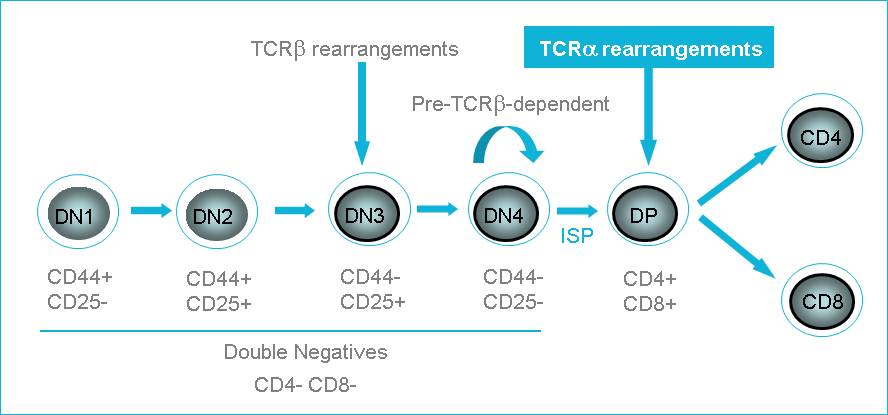BiteSized Immunology: Immune Development

T-cell development in thymus
T cells are derived from haematopoietic stem cells that are found in the bone marrow. The progenitors of these cells migrate to and colonise the thymus. The developing progenitors within the thymus, also known as thymocytes, undergo a series of maturation steps that can be identified based on the expression of different cell surface markers. The majority of cells in the thymus give rise to αβ T cells, however approximately 5% bear the γδ T cell receptor (TCR). Developing thymocytes interact with the thymus stromal (non-haematopoietic) cells, and undergo the process described below in distinct regions of the thymus. The thymus is made up of an outer cortex and an inner medulla region.
The earliest developing thymocytes lack the expression of the co-receptors CD4 and CD8 and are termed double negative (DN) cells. The DN population can be further sub-divided by the expression of CD44 (an adhesion molecule) and CD25 (Interleukin-2 receptor α chain), Figure 1 shows the ordered expression of these markers. Cells that lack expression of CD44, but express CD25 (DN3) undergo a process termed beta-selection. This process selects for cells that have successfully rearranged their TCR-β chain locus. The β chain then pairs with the surrogate chain, pre-Tα, and produces a pre-TCR, which forms a complex with CD3 molecules. This complex leads to the survival, proliferation, arrest in further β chain loci rearrangement, and further differentiation by up-regulation and expression of CD4 and CD8, these cells are termed double positive (DP) cells. Cells that do not undergo beta-selection die by apoptosis.

DP cells rearrange their TCR-α chain loci, to produce an αβ-TCR. These cells then undergo positive selection, in the cortex. DP cells interact with self-antigens in the context of major histocompatabilty complex (MHC) class I or class II molecules. Those cells that engage antigen/MHC with an appropriate affinity survive, whereas those cells that interact with a weaker affinity die by apoptosis. Thymocytes then migrate into the medulla to undergo negative selection. They are presented self-antigens on antigen presenting cells (APCs), such as dendritic cells and macrophages. Thymocytes that interact too strongly with antigen undergo apoptosis. The majority of developing thymocytes die during this process. Following selection, down-regulation of either co-receptor produces either naïve CD4 or CD8 single positive cells that exit the thymus and circulate the periphery.
© The copyright for this work resides with the BSI.
This was updated in 2022
